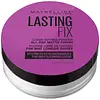Maybelline Lasting Fix Setting + Perfecting Loose Powder Versus NARS Cosmetics Light Reflecting Loose Setting Powder
What's inside
What's inside
 Key Ingredients
Key Ingredients

 Benefits
Benefits

 Concerns
Concerns

 Ingredients Side-by-side
Ingredients Side-by-side

Silica
AbrasiveDimethicone
EmollientLauroyl Lysine
Skin ConditioningTrimethylsiloxysilicate
EmollientAscophyllum Nodosum Extract
Skin ConditioningGlycerin
HumectantMagnesium Silicate
AbsorbentTocopheryl Acetate
AntioxidantPolysilicone-2
Ethylhexylglycerin
Skin ConditioningWater
Skin ConditioningCitric Acid
BufferingCI 77120
Cosmetic ColorantAlumina
AbrasiveSea Water
HumectantChlorphenesin
AntimicrobialPotassium Sorbate
PreservativePhenoxyethanol
PreservativeIron Oxides
Mica
Cosmetic ColorantCI 77891
Cosmetic ColorantSilica, Dimethicone, Lauroyl Lysine, Trimethylsiloxysilicate, Ascophyllum Nodosum Extract, Glycerin, Magnesium Silicate, Tocopheryl Acetate, Polysilicone-2, Ethylhexylglycerin, Water, Citric Acid, CI 77120, Alumina, Sea Water, Chlorphenesin, Potassium Sorbate, Phenoxyethanol, Iron Oxides, Mica, CI 77891
Ingredients Explained
These ingredients are found in both products.
Ingredients higher up in an ingredient list are typically present in a larger amount.
Dimethicone is a type of synthetic silicone created from natural materials such as quartz.
What it does:
Dimethicone comes in different viscosities:
Depending on the viscosity, dimethicone has different properties.
Ingredients lists don't always show which type is used, so we recommend reaching out to the brand if you have questions about the viscosity.
This ingredient is unlikely to cause irritation because it does not get absorbed into skin. However, people with silicone allergies should be careful about using this ingredient.
Note: Dimethicone may contribute to pilling. This is because it is not oil or water soluble, so pilling may occur when layered with products. When mixed with heavy oils in a formula, the outcome is also quite greasy.
Learn more about DimethiconeSilica, also known as silicon dioxide, is a naturally occurring mineral. It is used as a fine, spherical, and porous powder in cosmetics.
Though it has exfoliant properties, the function of silica varies depending on the product.
The unique structure of silica enhances the spreadability and adds smoothness, making it a great texture enhancer.
It is also used as an active carrier, emulsifier, and mattifier due to its ability to absorb excess oil.
In some products, tiny microneedles called spicules are made from silica or hydrolyzed sponge. When you rub them in, they lightly polish away dead skin layers and enhance the penetration of active ingredients.
Learn more about Silica